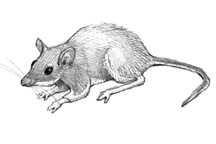Chesapeake Bay's Independent Newspaper ~ Since 1993
1629 Forest Drive, Annapolis, MD 21403 ~ 410-626-9888
Volume xviii, Issue 9 ~ March 4 - March 10, 2010
Home \\ Correspondence \\ from the Editor \\ Submit a Letter \\ Classifieds \\ Contact Us
Best of the Bay \\ Dining Guide \\ Home & Garden Guide \\ Archives \\ Distribution \\ Advertising![]()


Cat and MouseFelix sylvestris catusI am sitting at the computer, struggling to come up with the first sentence — always a challenge — when I see Ginger, basking in a bright rectangle of light on the wood floor. On bright winter afternoons, she seeks the sunny spots that slide across the floor. First sentence done. Ginger is a shorthaired tabby domestic feline. Compact, short-legged and well proportioned, she weighs only eight pounds. No longer a kitten, she is eight years old but still likes to play. She is well socialized, curious and unafraid of adults — but wary of kids. When I finish the task of writing, I might make a move to the couch. If Ginger is not sleeping — as she does about 16 hours a day — and she sees me make my move, she will meet me there, and I will have a moment with her. Our two cats show affection to us and, sometimes, to our friends. Having received lots of attention from us when they were kittens, they respond to us the way a child does to its parents. Domestic life, for pets such as our cats, is one long childhood. The scientific term is neotony.
Of the multiple theories of why cats became domesticated, the most likely one is that Ginger’s wild ancestors found human settlements accommodating to their needs. The cats might have had a natural propensity towards domestication. Humans, in turn, tolerated them and appreciated their help in controlling the mouse and rat populations. Compared to other domesticated animals such as dogs, cats are not very different from their wild ancestors. They are somewhat smaller and live in a state of permanent adolescence, but they hold on to a remarkable ability to survive in the great outdoors. The population of self-sustaining, feral cats in the U.S. is estimated to be at least 25 million and possibly much higher. It is hard to tell, because cats rarely cooperate with census takers. For cats such as Ginger and her co-cat Hazel, living with us amounts to symbiotic social adaptation. In other words, we like them and they like us, so we adapt to each other. Which species has adapted more might be subject to debate. For example, my brother Mark does not seem like your typical cat-lover, take my word. Nevertheless, he just paid a $1,000 bill to the cat vet. His paycheck also covers the cost of housing and feeding little Felix. There aren’t many cats bringing home paychecks to help with the rent. … and Mus musculus
Better beans and bacon in peace than cakes and ale in fear. Those were the words the Country Mouse spoke as he fled his City cousin’s home and returned to the safe but humble place where the fare was simple but where he could dine in peace. By late October, when the first blast of cold winds come barreling out of the northwest, it might be too late. If I was lazy, and that is my usual disposition, I might have been too late to seal up the vents and cracks in the foundation. Too late to stop a white-footed mouse from sneaking into the crawl space and gaining access to the kitchen and pantry. When we notice Hazel the cat seeming to stare under the oven for hours, fixated by the subtle signal that a Country Mouse has decided to become a City Mouse and take up residence for the winter, we know that I was too late. Just about every winter it seems that one or more of the furry, four-footed little animals finds its way into our kitchen. They spend three seasons of the year invisible to us though just outside our door. Hazel is a pretty good mouser; she makes the other cat look like a slacker. Sorry Ginger, but it’s true. So far this winter, Hazel has caught two mice, and I am grateful for the service she provides. I don’t like the thought of mice in the house. They eat stored food. They can chew the insulation from electrical wires, which can lead to a house fire. They bring fleas and disease into the house, and they leave their smelly droppings behind Mice are pests, but when I bend to sweep a dead mouse into the dustpan, I am caught off guard by the sight of it. The miniature creature looks perfect, beautiful and innocent. Gray and white never looked better. Mus musculus thrives around humans. They often live in fields, but are commonly found in or near homes and commercial buildings. They are capable of squeezing their tiny bodies into impossibly small cracks and crevices to gain access to buildings. They generally prefer plant matter: fruits, vegetables and grains, but they will also eat meat. I finally got around to sealing up the foundation. I hope I did a good-enough job to keep out invading rodents. I take it as a positive sign that we haven’t recently seen Hazel staring under the stove for hours at a time. Scientific name: Mus musculus What to look for: Small, gray rodent with gray and white fur. Signs of infestation: Musty smell, small droppings, chew marks on food containers; unusual cat behavior. |
© COPYRIGHT 2010 by New Bay Enterprises, Inc. All rights reserved.


